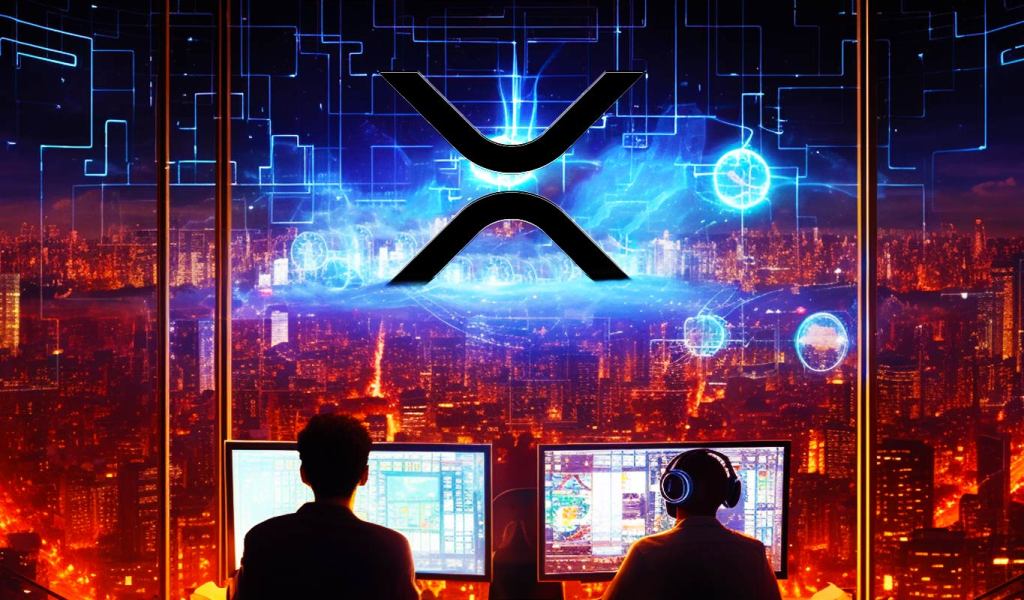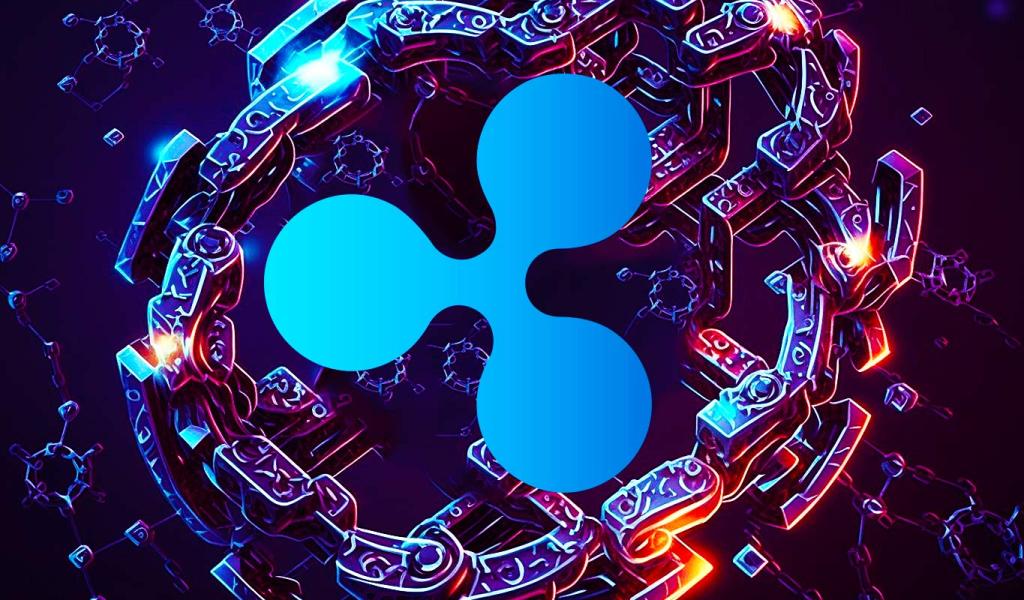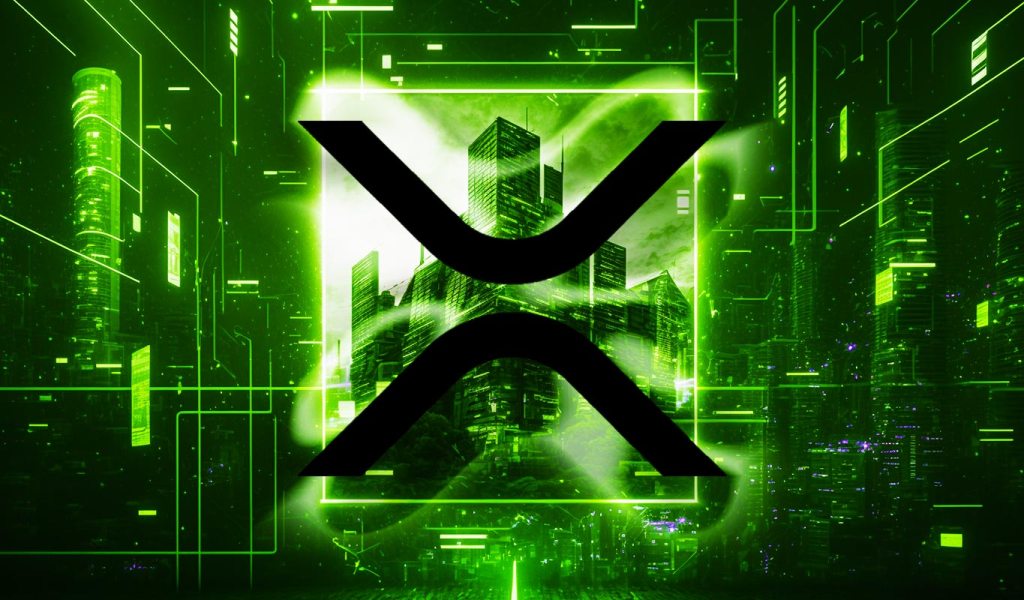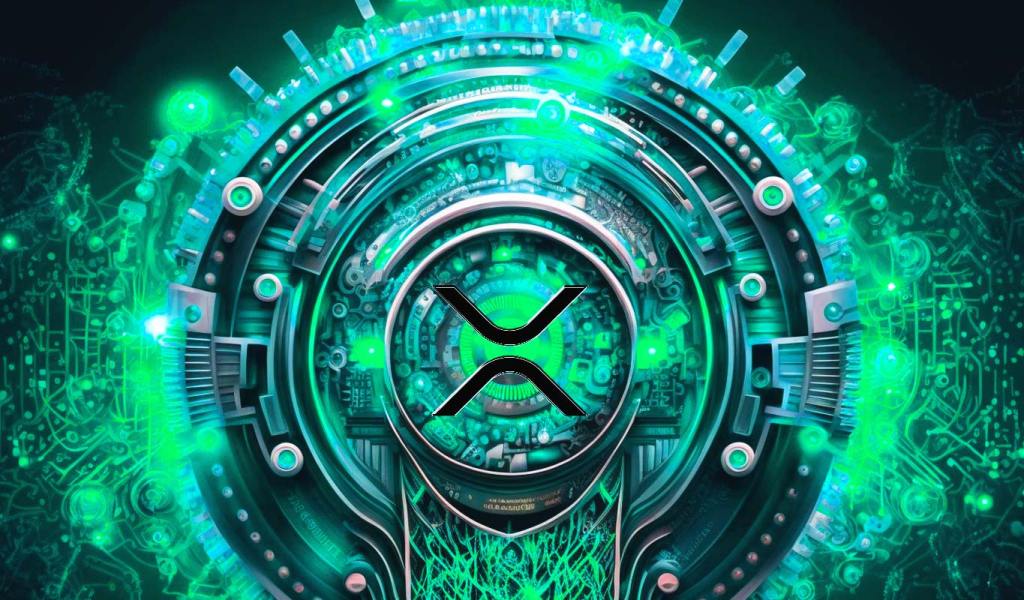
Payments firm Ripple has inked a new partnership with the Tokyo-based arm of HashKey Group in an effort to bring XRP Ledger-based supply chain finance solutions to Japan. Ripple and HashKey DX, a Japanese consulting company of the HashKey Group, will also work with Japanese financial services giant SBI Holdings, which has been partnered with […]
The post Ripple Forms Partnership With Tokyo Unit of $1,200,000,000 Firm To Push for XRPL-Powered Solutions in Japan appeared first on The Daily Hodl.

Non-fungible token (NFT) activity is exploding on the XRP Ledger (XRPL), according to a recent update from Ripple. In a new quarterly report, Ripple notes that more than half of all the NFTs ever minted on the XRPL since the release of the XLS-20 standard in 2022 happened in the fourth quarter of 2023. The […]
The post Number of Non-Fungible Token Mints on the XRP Ledger Surged by More Than 400% in 2023 Q4, According to Ripple appeared first on The Daily Hodl.

Payments company Ripple has launched a new partnership to help enable cross-border payments between Africa and a slew of other markets. Ripple says in a new press release that it is partnering with Onafriq, a fintech firm with a network spanning 40 African markets. Onafriq will use Ripple’s crypto-enabled payments technology to launch payment corridors […]
The post Ripple Strikes New Partnership To Enable Cross-Border Payments Between UK, Australia, Gulf Countries and Africa appeared first on The Daily Hodl.

Crypto analytics platform Messari says Ripple is working with governments across the globe to explore central bank digital currencies (CBDCs) built atop the XRP Ledger (XRPL) blockchain. According to Messari, Ripple is collaborating with over a dozen countries on CBDCs that will run on the XRPL blockchain. The XRP Ledger uses XRP as the native […]
The post XRPL at the Forefront of CBDC Explorations by Governments, Says Analytics Firm Messari appeared first on The Daily Hodl.

Ripple says the “in principle” approval will help scale its “On-Demand Liquidity,” the service it uses to source XRP liquidity to customers.
Blockchain-based payments firm Ripple has obtained in-principle regulatory approval from Singapore’s financial regulator to offer digital asset payments and token products in the city-state.
Ripple confirmed the approval from the Monetary Authority of Singapore (MAS) in a June 22 statement. The approval will allow its subsidiary, Ripple Markets Asia Pacific, to further scale its On-Demand Liquidity. The ODL helps Ripple’s customers to move XRP around the world without the banks intervening as intermediaries.
We’re honored to obtain In-Principle Approval of a Major Payments Institution License from the @MAS_sg – allowing us to offer regulated digital asset products and services, and scale customer use of #ODL.
— Ripple (@Ripple) June 22, 2023
Learn more: https://t.co/8Ylc3lZSeg
The firm applied for the institutional payment license under Singapore’s Payment Service Act.
Ripple CEO Brad Garlinghouse praised the Singaporean regulator for its “pragmatic, innovation-first approach” to cryptocurrency-related services, adding that the country will provide a “prominent gateway” for Ripple’s business operations in the Asia Pacific region.
Ripple’s chief legal officer, Stu Alderoty, also noted that Singapore’s “early leadership” is paving the way for other regulators looking to develop a “clear taxonomy and licensing framework.”
1/ @MAS_sg has built a workable framework that truly unites consumer protection, market integrity and innovation. They’ve also outlined a clear taxonomy to classify and regulate digital assets – making it possible for companies like Ripple to build and offer compliant products. https://t.co/KLYzWRrST0
— Stuart Alderoty (@s_alderoty) June 22, 2023
Alderoty explained that the approval expands upon Ripple’s customer reach.
“This in-principle regulatory approval from the MAS will enable us to better support our forward-thinking customers looking to hone in on blockchain and crypto technologies to build a more inclusive and borderless financial system.”
In 2022, Ripple managed to double the number of employees in its Asia Pacific headquarters as its Singapore base experienced a majority share of ODL transactions flowing through the city-state.
The MAS released its own Purpose Bound Money white paper on June 21, which proposes standards for fintech firms providing digital money services in Singapore:
.@MAS_sg published a whitepaper proposing a common protocol to specify conditions for the use of digital money such as CBDCs, tokenised bank deposits, and stablecoins on a distributed ledger.
— MAS (@MAS_sg) June 21, 2023
READ: https://t.co/ZzY0OjOG1n
While Ripple’s path to compliance with Singapore came without much in the way of legal barriers, this hasn’t been the case elsewhere.
Ripple’s legal team has had their hands tied with the U.S. Securities Exchange Commission since December 2020 after the regulator sued them for allegedly offering XRP — the token that powers XRP Ledger — as an unregistered security.
A ruling is set to be made on the high-profile case in the coming months, according to Garlinghouse.
Related: Ripple vs. SEC: Could newly released documents tip the balance?
On June 15, Ripple partnered with Colombia’s central bank, Banco de la República, to pilot a central bank digital currency on its XRP Ledger.
The firm has also partnered with central banks in Montenegro and Thailand, in addition to many other regional banks and financial institutions around the world.
Magazine: Crypto regulation — Does SEC Chair Gary Gensler have the final say?

The court case between SEC and Ripple Labs has been ongoing for nearly two and a half years, but a summary judgment ruling could be made any day.
The ongoing case of the Securities and Exchange Commission v Ripple Labs could have a significant impact on the future of cryptocurrency regulations.
Ripple first popped up in 2012 with the promise of providing financial institutions and other entities with faster, more affordable clearance of cross-border fund transfers. To that end, Ripple created the XRP Ledger and a cryptocurrency called XRP (XRP) to function as its native coin and facilitate transactions.
On Dec. 22, 2020, the SEC sued Ripple, alleging that the firm selling XRP represented an unregistered securities offering.
Ripple co-founder and former CEO Chris Larsen and current CEO Brad Garlinghouse were also named in the SEC’s charges.
Most entities on the receiving end of SEC enforcement actions choose to settle. In this case, however, Ripple chose to fight the charges — at great expense — and take the matter to court.
Ripple argued that XRP does not satisfy the Howey test, which is used to determine whether an investment contract exists — and, therefore, whether a transaction is a security transaction. It also said that if XRP was, in fact, a security, the SEC had failed to give it fair notice under U.S. securities laws.
The “Hinman documents” refer to a 2018 speech given by former SEC Director William Hinman and documents associated with writing it.
In the speech, Hinman said that Ether (ETH) should not be considered a security given its decentralized nature, stating:
“Putting aside the fundraising that accompanied the creation of Ether, based on my understanding of the present state of Ether, the Ethereum network and its decentralized structure, current offers and sales of Ether are not securities transactions.”
This was considered a landmark speech, as it signaled to the crypto industry that it could be possible for cryptocurrencies to transition from securities when they are first created to commodities once they are sufficiently decentralized.
This could have an impact on Ripple’s fair notice defense, which comes into play if Judge Analisa Torres finds that Ripple did indeed sell unregistered securities.
@attorneyjeremy1 is correct and this is why Ripple’s Fair Notice Defense should be viewed as an insurance policy. If the Judge finds Ripple violated Section 5 b/c these specific sales constituted investment contracts, Ripple argues the jury must decide if Ripple had fair notice.
— John E Deaton (@JohnEDeaton1) May 18, 2023
Ripple requested the documents in discovery, and the request was granted on Oct. 21, 2022. While the documents could be used as a part of Ripple’s defense, the SEC has attempted to keep them sealed on multiple occasions, arguing that they are irrelevant to the court’s summary judgment decision.
But on May 16, Judge Torres ruled that the Hinman documents are “judicial documents” subject to a strong presumption of public access and denied the SEC’s motion to seal.
Another win for transparency! Unredacted Hinman emails to be publicly available soon - stay tuned as the lawyers work through the mechanics to make that happen. https://t.co/o6puPypRHd https://t.co/qmaLVeQaP8
— Brad Garlinghouse (@bgarlinghouse) May 16, 2023
Notably, the court did not state whether the documents will be relied upon when it decides on the summary judgment motions of each party; but given the statements of those who have seen the documents, it appears likely they will negatively affect the public image of the SEC.
I’ve always felt good about our legal arguments, and I feel even better now.
— Stuart Alderoty (@s_alderoty) October 20, 2022
I always felt bad about the SEC’s tactics, and I feel even worse about them now.
Additionally, there are questions about whether Hinman had a conflict of interest when making the speech, as he worked at a law firm that is a member of an Ethereum advocacy organization before and after working for the SEC— and the documents may provide additional details around this.
Speaking during a Twitter Space shortly after the ruling, lawyer and CryptoLaw founder John Deaton predicted the documents will be:
“Disturbing, but not as shocking as maybe people think it’s going to be because there’s been, quite frankly, such a big buildup for it. [...] I believe when these emails come out, that the conflicts of interest will be even more highlighted.”
While it’s still too early to tell what the ultimate outcome of the case will be, the court also denied certain motions to seal from Ripple, which included references linking Ripple’s revenues with XRP sales and the amount of compensation offered to trading platforms, among others.
In the Twitter Space, Deaton highlighted these sections as evidence likely to hurt Ripple’s chances of a complete victory, adding:
“I think the chances of Ripple getting a complete victory are much slimmer after reading this than I felt before. I still don’t think the SEC is getting a complete victory either.”
Deaton theorized that the courts could decide to fine Ripple for its early sales of XRP — relating to the initial coin offering and other transactions aimed at boosting the network — but that secondary sales of XRP and the coin itself are not securities.
If the above scenario happens AND the Judge agrees w/Ripple that the jury must then decide whether those early sales should be excused because Ripple lacked fair notice that XRP sales were effectively illegal (unregistered), it can only be described as a TOTAL VICTORY for Ripple.
— John E Deaton (@JohnEDeaton1) May 18, 2023
Deaton’s thoughts on the subject were given further credibility when former SEC securities lawyer Marc Fagel added his voice to the Twitter Space, saying that he generally agreed with everything that had been said but that the SEC’s suit was worded in a way that focused on the tokens issued by Ripple and not secondary market transactions.
Fagel added that he thought Torres “would be overstepping to make a ruling on secondary sales,” but he believed they were helpful in the SEC’s case, as they illustrate how a secondary market would not have been created without Ripple issuing securities while promoting the network.
...is good and bad news IMO. A complete Ripple win would have given J. Torres an out to NOT order production. Same goes for SEC. Doesn't automatically mean neither can win outright but, as I have predicted, still think these are both low probabilities. Could compel SEC to...2/3
— Fred Rispoli (@freddyriz) May 16, 2023
In a May 17 Twitter thread, prominent pro-crypto lawyer Fred Rispoli suggested that the summary judgment ruling is already written and could be issued “any day now,” while also agreeing that a split decision was the most likely.
Deaton noted during the Twitter Space that he believes Judge Torres knows how she will rule but added that guessing how much is written “in its final form” would be pure speculation.
He also agreed that the decision could come down at any time, but he added that it could take another month or longer.
Magazine: NFT Creator: Top 10 crypto artist Trevor Jones on being rich, rekt and rich again

XRP Ledger (XRPL) developers have unveiled a new proposal for a cross-chain bridge they say would expand the blockchain’s functionality. Ripple software engineer Mayukha Vadari published the GitHub proposal and linked to it on Twitter. We just published an official XRPL Standards spec for cross-chain bridges! Check it out and let me know if you […]
The post XRP Ledger Developers Unveil New Proposal for Cross-Chain Bridge To Expand Blockchain’s Use Cases appeared first on The Daily Hodl.

Learn what Wrapped XRP is and how to use wXRP on blockchains other than Ripple’s XRP Ledger.
Wrapped XRP (wXRP) is a crypto asset pegged to XRP (XRP) and can be used on blockchains other than Ripple’s native XRP Ledger. Ripple is a blockchain-based global payments system providing crypto solutions for businesses, and XRP is the native currency of the Ripple network. Identical in value, its wrapped version, wXRP, can be used in financial payments and settlements on other blockchains.
This article will discuss why we need wXRP, how to buy wXRP, use cases of wXRP, and the purpose and safety of wXRP tokens.
Wrapped cryptocurrencies are tokens that are used as cryptocurrencies on blockchains other than the original blockchain they were built on. The value of wrapped crypto is the same as its original cryptocurrency (1:1). This allows cryptocurrencies like Bitcoin (BTC), Ether (ETH) or XRP to be used on chains other than their native blockchains, thereby increasing their utility.
The purpose of wrapped cryptocurrencies is to help solve the problem of decentralized finance (DeFi) cross-chain liquidity. If each cryptocurrency stays in its own ecosystem, growth is contingent on demand in that ecosystem alone. It would essentially be operating in a closed system.
Wrapped crypto solves this by providing blockchain interoperability among different cryptocurrencies and blockchains. This opens avenues for improving cross-chain liquidity for DeFi ecosystems and boosts crypto asset utility.
Related: Wrapped crypto tokens, explained
XRP is a cryptocurrency that runs on the native XRP Ledger and facilitates transactions on the Ripple Network. One can purchase XRP for financing transactions, investing or exchanging crypto on Ripple. For a transaction involving the use of XRP on any other blockchain than Ripple, Wrapped XRP will be used.
Wrapping XRP increases the scope and utility of XRP to be used on multiple blockchains other than its native XRP Ledger. For instance, wXRP on the Ethereum blockchain would enable its users to turn XRP into a yield-bearing asset by trading, staking, pooling or utilizing Ethereum wallets, decentralized applications (DApps), games and more to diversify their portfolio.
Wrapped XRP is a 1:1 equivalent of XRP. Its value is pegged to XRP due to arbitrage, similar to a stablecoin like USD Coin (USDC) or Binance USD (BUSD) being pegged to the United States dollar. WXRP is fully collateralized and held with a custodian that makes sure that each wXRP is backed by an equivalent XRP reserve. Both wrapping and unwrapping follow a 1:1 ratio. There is no other cost apart from transaction fees on the blockchain.
When users wrap their XRP, they simply send their cryptocurrency to a smart contract that provides them with the wrapped tokens. The XRP is stored and then returned when someone else unwraps their wrapped token. One can choose to unwrap their wrapped XRP token at any time. This gives users freedom and the ability to freely convert between wXRP and XRP as per their requirements and the blockchain they are on.
Wrapping XRP allows XRP to be used on blockchains other than XRP Ledger. But how exactly does this work? In the case of wrapped cryptocurrencies, there needs to be a custodian that guarantees the same value of the original crypto as its wrapped version.
The custodian could be anybody, a decentralized autonomous organization (DAO), a smart contract, multisig wallets or simply a code rule. The custodian wraps the crypto, called minting, and returns back to the original version, called burning. For XRP, the smart contract serves as the custodian.
When a user wraps XRP, the smart contract provides them with the wrapped version for use on other blockchains, while the original XRP gets stored with a custodian. It returns to circulation when someone unwraps their wXRP. The original form is then sent back to its original blockchain, XRP Ledger. Therefore, each wXRP is backed by a single XRP in reserve, which helps to maintain its peg.
The price value is pegged because of trading arbitrage. If wXRP falls below XRP’s price, traders will see an opportunity for arbitrage profit and purchase the cheaper wXRP to unwrap and sell it for a profit. This increased wXRP demand would reduce supply and raise the price, helping reach the peg. Similarly, if the price of wXRP rises above XRP, trading pressure to sell wXRP will increase in turn, increasing the supply and leading to price reduction until it reaches the 1:1 value peg.
Wrapping XRP has many benefits for XRP holders. Some of these include:
Wrapping XRP enhances blockchain interoperability for XRP holders. It enables XRP holders to take advantage of trading benefits across different chains. It also provides an opportunity for accessing services of various DApps or DeFi protocols, allowing for better use cases and more returns.
A significant benefit that comes with the utilization of wrapped tokens is the increase in liquidity. XRP is a popular cryptocurrency listed on various centralized exchanges (CEXs) and decentralized exchanges (DEXs).
For XRP holders, this opens increasing avenues to diversify portfolios and ensure liquidity, especially in Ethereum’s developed DeFi ecosystem, which offers ample options. CEXs, such as Binance, and DEXs, such as Uniswap and SushiSwap, offer wXRP pool pairings for staking, swapping, lending, etc.
The use cases of wrapped XRP are increasing each day as the crypto landscape develops. Two common and interesting use cases include:

Apart from these, strides are being made in yield farming, automated market maker pools, loan collateral using wrapped cryptocurrencies and more. As cross-chain bridges and interoperability grow, use cases for wrapped cryptocurrencies will continue to rise.
For XRP holders looking to put their XRP to use across other blockchains, it is important to be able to wrap your crypto. Wrapped.com from TokenSoft is the leading provider of wrapped cryptocurrencies, and one can use its services to wrap or unwrap XRP. In collaboration with Hex Trust as the custodian, they provide the infrastructure to mobilize wXRP on the Ethereum blockchain.
Create an account using their Typeform, and details on conversion will be reflected by wrapped.com. For SushiSwap, wrapped.com offers a direct integration using MetaMask wallet. XRP may also be wrapped on various blockchains through alternate wrapping service providers, such as ApexSwap, which bridges from Avalanche to the XRP Ledger.
Wrapped tokens have made cryptocurrencies efficient and useful. Protocols like Ethereum convert wrapped crypto to ERC-20 tokens to allow users to execute transactions safely. However, one of the areas of possible weakness for wrapped tokens is the custodian that holds the underlying asset. If the custodian turns rogue and unlocks and releases the original XRP to someone else, tokenholders of the wrapped XRP would be left with a worthless asset.
The custodian is a centralized entity in this transaction and should be a trusted party. In the case of XRP, Ripple has chosen Hex Trust, Asia’s leading digital asset custodian, to be the trusted party. Such vetted networks and their custodians tend to back up guarantees and insurances to prevent any wrongdoings with the aim to ensure wrapped token safety.
Going forward, decentralized smart contract-managed bridges will be interesting to explore as a custodian and are a topic of interesting deliberations and discussion in the blockchain world, especially since wrapped tokens have started to play a significant role in the growth of DeFi services.

An AI chatbot alleged Ripple can secretly control its blockchain through an undisclosed backdoor in the network's code and has been ridiculed by the firm's CTO.
Ripple’s chief technology officer has responded to a conspiracy theory fabricated by Artificial Intelligence (AI) tool ChatGPT, which alleges the XRP Ledger (XRPL) is somehow being secretly controlled by Ripple.
According to a Dec. 3 Twitter thread by user Stefan Huber, when asked a series of questions regarding the decentralization of Ripple’s XRP Ledger, the ChatGPT bot suggested that while people could participate in the governance of the blockchain, Ripple has the “ultimate control” of XRPL.
Asked how this is possible without the consensus of participants and its publicly-available code, the AI alleged that Ripple may have “abilities that are not fully disclosed in the public source code.”
At one point, the AI said “the ultimate decision-making power” for XRPL “still lies with Ripple Labs” and the company could make changes “even if those changes do not have the support of the supermajority of the participants in the network.”
It also contrasted the XRPL with Bitcoin (BTC) saying the latter was “truly decentralized.”
However, Ripple CTO David Schwartz has called the bot’s logic into question, arguing that with that logic, Ripple could secretly control the Bitcoin network as it neither can be determined from the code.
If it's final argument is that Ripple Labs "may have" some secret way to control the XRP Ledger that cannot be determined from the public code, why not argue that Ripple Labs "may have" some secret way to control the bitcoin blockchain that cannot be determined from the code?
— David "JoelKatz" Schwartz (@JoelKatz) December 5, 2022
The bot was also shown to contradict its own statements in the interaction, stating that the main reason for using “a distributed ledger like the [XRPL] is to enable secure and efficient transactions without the need for a central authority,” which contradicts its statement that the XRPL is managed centrally.
Related: Ripple files final submission against SEC as landmark case nears end
ChatGPT is a chatbot tool built by AI research company OpenAI which is designed to interact “in a conversational way” and answer questions about almost anything a user asks. It can even complete some tasks such as creating and testing smart contracts.
The AI was trained on “vast amounts of data from the internet written by humans, including conversations” according to OpenAI and warned because of this some of the bot's reponses can be “inaccurate, untruthful, and otherwise misleading at times.”
OpenAI CEO Sam Altman said upon its release on Nov. 30 that its “an early demo” and is “very much a research release.” The tool has already seen over one million users according to a Dec. 5 tweet by Altman.
Ethereum founder Vitalik Buterin also weighed in on the AI chatbot in a Dec. 4 tweet saying the idea that AI “will be free from human biases has probably died the hardest.”
Of all the optimistic 00s era takes, "AI will think logically from first principles so it will be free from human biases" has probably died the hardest. https://t.co/5rz33AEgKb
— vitalik.eth (@VitalikButerin) December 4, 2022

Non-fungible tokens (NFTs) are now live on the XRP Ledger (XRPL) after a new amendment enabling extensions supporting a native NFT type on the ledger was activated. David Schwartz, Ripple’s chief technology officer, says in a new blog post that RippleX engineers built the new feature using a no-smart-contracts approach to increase its cost-effectiveness and […]
The post Ripple CTO Identifies Key Milestone As XRP Ledger Sees NFTs Go Live on Mainnet appeared first on The Daily Hodl.